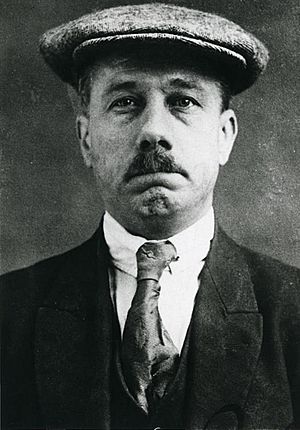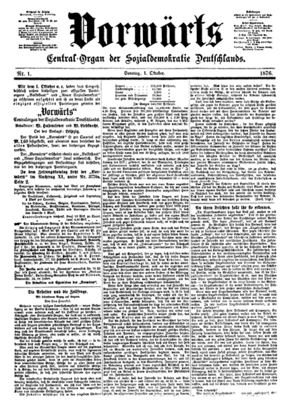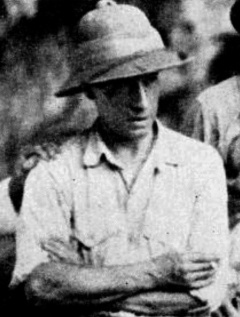B. Traven facts for kids
B. Traven was the pen name of a writer. No one knows his real name, where he was born, or when. Most people think he was German.
One thing we know for sure is that Traven lived in Mexico for many years. Most of his stories are set there. This includes The Treasure of the Sierra Madre (1927). A movie made from this book won three Academy Awards in 1949.
Contents
The Mystery of B. Traven's Life
Almost everything about B. Traven's life is a mystery. Many people have guessed who he really was. Some of these ideas were very wild!
The name most often linked to B. Traven is Ret Marut. He was a German stage actor and an anarchist. Anarchists believe in societies without rulers. Marut also ran an anarchist newspaper in Germany called Der Ziegelbrenner.
Traven's wife, Rosa Elena Luján, said after his death in 1969 that her husband and Ret Marut were the same person. Ret Marut was also a pen name. It might have come from old Hindu stories.
Who Was B. Traven Really?
Only one name linked to the author has a birth record. This was Hermann Albert Otto Maximilian Feige. He was born in Schwiebus, Germany, on February 23, 1882. Marut gave this name and date to the American Embassy in London in 1923. He was applying for a passport at the time.
However, not everyone agrees that this was his true identity. No one has found proof against it, though. In Mexico, B. Traven was also connected to the names Berick Traven Torsvan and Hal Croves. These people appeared at different times in the writer's life. Both said they were not Traven. They claimed they were only his agents, helping him talk to publishers.
B. Traven's Books and Stories
B. Traven wrote twelve novels, one book of reports, and several short stories. His books are exciting adventure stories. They also criticize capitalism, which is an economic system.
Some of his most famous books include:
- The Death Ship (1926)
- The Treasure of the Sierra Madre (1927), which was made into a movie by John Huston in 1948.
- The "Jungle Novels," also called the Caoba cyclus. Caoba is the Spanish word for mahogany.
The Jungle Novels are a group of six books. They include The Carreta and Government. These books were published between 1930 and 1939. They are about Mexican Indians just before and during the Mexican Revolution in the early 1900s.
Traven's books became very popular between the two World Wars. They stayed popular after World War II too. They were translated into many languages. Most of B. Traven's books first came out in German. Their English versions came out later. But the author always said the English versions were the originals. He claimed the German ones were just translations. Most experts think this was a joke or a way to hide his identity.
B. Traven's Works
His Novels
The writer B. Traven first appeared in German literature in 1925. On February 28, the Berlin newspaper Vorwärts published his first short story. This paper was linked to the Social Democratic Party of Germany. Soon after, it published Traven's first novel, Die Baumwollpflücker (The Cotton-Pickers). It came out in parts in June and July of that year.
The full book was published in 1926 by Buchmeister. This publishing house was owned by a group linked to trade unions. The first book title was Der Wobbly. This was a common name for members of a union called Industrial Workers of the World. Later, the original title Die Baumwollpflücker was used again.
In this book, Traven introduced a character named Gerald Gales. He is an American sailor looking for work in Mexico. He often meets strange people and sees how workers are treated unfairly. But he never gives up hope or his joy for life.
In 1926, Traven's publisher, Büchergilde Gutenberg, released his second novel, Das Totenschiff (The Death Ship). The main character is again Gerard Gales. He is a sailor who loses his papers. This means he loses his identity and his right to a normal life. He is forced to work in terrible conditions on a "death ship." This kind of ship is unsafe and often sinks. It sails on strange trips around Europe and Africa.
The novel criticizes greedy bosses and officials. These officials send Gale away from countries where he seeks safety. Some experts believe The Death Ship has parts of Traven's own life in it. If B. Traven was Ret Marut, then Gale's story is like the writer's. He might have been forced to work on a ship from Europe to Mexico.
Traven's most famous novel, besides The Death Ship, is The Treasure of the Sierra Madre. It was first published in German in 1927. The story is set in Mexico. Its main characters are American adventurers looking for gold. In 1948, John Huston made the book into a movie. The film, starring Humphrey Bogart, was a big hit. It won three Academy Awards in 1949.
Gerald Gales returned in Traven's next book, The Bridge in the Jungle. It was published in parts in Vorwärts in 1927. The full book came out in 1929. In this novel, Traven wrote about Native peoples in North and South America. He showed the differences between their cultures and the cultures of white settlers. These ideas were important in the Jungle Novels published in the 1930s.
In 1929, B. Traven's longest book, The White Rose, was published. This was a long story, possibly based on real events. It was about land taken from Native American people by an American oil company.
The 1930s were when Traven wrote and published the Jungle Novels. This series has six books:
- The Carreta (1931)
- Government (1931)
- March to the Monteria (1933)
- Trozas (1936)
- The Rebellion of the Hanged (1936)
- General from the Jungle (1940)
These novels describe the lives of Native Mexicans in Chiapas, Mexico, in the early 1900s. They were forced to work in terrible conditions cutting mahogany in jungle camps. These harsh conditions led to a rebellion and the start of the Mexican Revolution.
After the Jungle Novels, B. Traven mostly stopped writing long stories. He only published short stories. One was a Mexican fairy tale called Macario, first published in German in 1950. The English title was The Healer. The New York Times called it the best short story of 1953. Macario was made into a movie by Mexican director Roberto Gavaldón in 1960.
Traven's last novel, Aslan Norval, was published in 1960. It is about a rich American woman married to an older businessman. She is also in love with a young man. She wants to build a canal across the United States. This canal would be an alternative to the nuclear arms race and space programs. The book's topic and writing style were very different from Traven's other works. Publishers doubted he wrote it and called it "trivial." The book was only accepted after its language was changed to sound more like Traven's style. Doubts about Aslan Norval still exist. This adds to the mystery of who B. Traven was and who wrote his books.
Other Works by B. Traven
Besides his twelve novels, B. Traven also wrote many short stories. Some have never been published. Along with Macario, he also wrote a Mexican legend called The Creation of the Sun and the Moon. The first collection of Traven's short stories, Der Busch, came out in 1928. A bigger version was published in 1930. From the 1940s, many of his short stories appeared in magazines and books in different languages.
One unique book by Traven is Land des Frühlings (Land of Springtime, 1928). It is a travel book about the Mexican state of Chiapas. It also shares the author's leftist and anarchist ideas. The book included 64 pages of photos taken by B. Traven himself. It has not been translated into English.
Main Ideas in Traven's Books
B. Traven's main writings are adventure novels with themes about working-class people. They tell stories of exciting travels, brave outlaws, and Native Americans. Many of his ideas can also be found in books by Karl May and Jack London.
But Traven's books are different from most adventure stories. They describe the lives of his characters in detail. They also show the world from the point of view of "the oppressed and exploited." Traven's characters are usually from the lower classes of society. They are often more like antiheroes than traditional heroes. An antihero is a main character who lacks typical heroic qualities. But they have a strong will to fight. Ideas like "justice" or Christian morals, which are important in other adventure novels, are not as important here.
Instead, a spirit of rebellion is often at the heart of the story. The hero's refusal to accept bad living conditions often drives the plot. The books focus on how oppressed people try to free themselves.
Traven's books do not offer clear political plans. His clearest message might be the anarchist demand "¡Tierra y Libertad!" (Land and Liberty!) in the Jungle Novels. Professional politicians, even those who support the left, are usually shown in a negative way. Despite this, Traven's books are very political. The author does not offer solutions, but he always shows what causes his heroes' suffering. For him, this cause is capitalism. He calls it Caesar Augustus Capitalismus.
Traven's criticism of capitalism is not preachy. By writing his novels as adventure or Western stories, he wanted to reach less educated people, especially the working class.
Traven did not just criticize capitalism. He also focused on the unfair treatment of Mexican Indians. These ideas, especially in the Jungle Novels, were new in the 1930s. Most thinkers on the left, even if they disliked European and American control, did not know or care about the unfair treatment of native people in Africa, Asia, or South America. Some say Traven deserves credit for bringing attention to these issues. He did this long before movements against colonialism and for civil rights for black people in the United States.
The Mystery of B. Traven's Identity
Traven sent his works for publication from Mexico to Europe by mail. He gave a Mexican post office box as his return address. The copyright holder listed in his books was "B. Traven, Tamaulipas, Mexico."
No one from his European or American publishers ever met him in person. Or, at least, the people they talked to about publishing and filming his books always said they were only Traven's literary agents. The writer's identity was to be kept secret. B. Traven explained why he kept his life private with a famous quote: "The creative person should have no other biography than his works."
Even though the writer's popularity grew, B. Traven remained a mysterious figure. Experts and journalists tried to find out who he was. They came up with many ideas, some believable, some not.
List of Works by B. Traven
Stand-alone Novels
- The Cotton-Pickers (1926; also called The Wobbly) ISBN: 1-56663-075-4
- The Treasure of the Sierra Madre (1927; first English edition 1935) ISBN: 0-8090-0160-8
- The Death Ship: The Story of an American Sailor (1926; first English edition 1934) ISBN: 1-55652-110-3
- The White Rose (1929; first full English edition 1979) ISBN: 0-85031-370-8
- The Night Visitor and Other Stories (English edition 1967) ISBN: 1-56663-039-8
- The Bridge in the Jungle (1929; first English edition 1938) ISBN: 1-56663-063-0
- Land des Frühlings (1928) – a travel book, not translated into English
- Aslan Norval (1960) ISBN: 978-3-257-05016-5 – not translated into English
- Stories by the Man Nobody Knows (1961)
- The Kidnapped Saint and Other Stories (1975)
- The Creation of the Sun and the Moon (1968)
The Jungle Novels Series
- Government (1931) ISBN: 1-56663-038-X
- The Carreta (1931, released in Germany 1930) ISBN: 1-56663-045-2
- March to the Monteria (also known as March to Caobaland) (1933) ISBN: 1-56663-046-0
- Trozas (1936) ISBN: 1-56663-219-6
- The Rebellion of the Hanged (1936; first English edition 1952) ISBN: 1-56663-064-9
- General from the Jungle (1940) ISBN: 1-56663-076-2
Collected Short Stories
- Canasta de cuentos mexicanos (or Canasta of Mexican Stories, 1956, Mexico City, translated from English by Rosa Elena Luján) ISBN: 968-403-320-6
Movies Based on B. Traven's Works
- The Treasure of the Sierra Madre, 1948
- The Rebellion of the Hanged, 1954
- Canasta de cuentos mexicanos, 1955
- The Argonauts (Episode of Cheyenne TV series), 1955
- Der Banditendoktor (TV film), 1957
- The Death Ship, 1959
- Macario (based on the story "The Third Guest"), 1960
- Rosa Blanca (based on the novel La Rosa Blanca), 1961
- Días de otoño (based on the story "Frustration"), 1963
- Au verre de l'amitié, 1970
- Die Baumwollpflücker (TV series), 1970
- The Bridge in the Jungle, 1971
- Kuolemanlaiva (TV film), 1983
- La rebelión de los colgados, 1986
Illustrations for B. Traven's Books
- Dödsskeppet (The Death Ship), Atlantis, Stockholm 1978, and Het dodenschip, Meulenhoff, Amsterdam 1978. These books have ink drawings by Swedish artist Torsten Billman. These illustrations have not been published in English.
Works by Ret Marut
- To the Honorable Miss S... and other stories (1915–19; English publication 1981) ISBN: 0-88208-131-4
- Die Fackel des Fürsten (novel, Nottingham: Edition Refugium 2009) ISBN: 0-9506476-2-4;ISBN: 978-0-9506476-2-3
- Der Mann Site und die grünglitzernde Frau – (novel, Nottingham: Edition Refugium 2009) ISBN: 0-9506476-3-2; ISBN: 978-0-9506476-3-0
See also
 In Spanish: B. Traven para niños
In Spanish: B. Traven para niños




